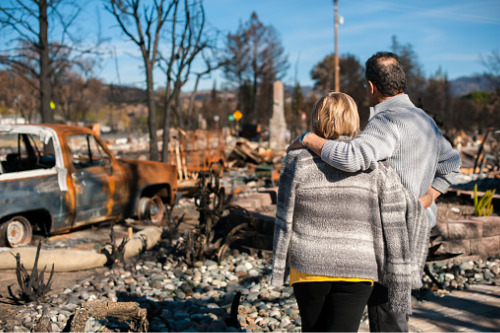

Nearly two million homes in the US are at risk from wildfires, according to new data from CoreLogic.
On Wednesday, the analytics provider released its 2020 Wildfire Risk Report, which found that 1,975,116 homes were at elevated risk of wildfire damage. The homes have a combined reconstruction cost of more than $638 billion.
The Los Angeles metro area has the greatest number of single-family residences at risk of wildfire damage, followed by Riverside, Calif., and San Diego. California is home to 76% of homes on the top 10 list, but the reconstruction value of these homes accounts for nearly 84% or the total.
“2017 and 2018 were incredibly destructive, record-setting years for wildfire, followed by a comparatively quieter 2019,” said Dr. Tom Jeffery, principal hazard scientist at CoreLogic. “When we talk about wildfire trends, it’s important to treat any decrease in fire activity as only temporary. Like most natural hazards, there is no reason to believe that the amount of wildfire acreage or the number of homes in the path of future wildfires will be any less – and certainly the ongoing 2020 season is proof of that, well on its way to being among the most devastating in recent memory.
Wildfires in California, Oregon and Washington have caused the loss of dozens of lives and thousands of structures – and recovery from wildfires can take years, CoreLogic said. Both Santa Rosa, which was devastated by the Tubb Fire in 2017, and Paradise, Calif., where the Camp Fire took place in 2018, are still rebuilding.
“This year, the COVID-19 pandemic has created additional complications to an already deadly peril, and with the potential for disruptions to the supply chain for raw materials, manufacturing and transportation, this effort could be further challenged,” CoreLogic said.
Insurance activities may also face challenges, with a flood of claims and fewer adjusters to review damages. This makes automation and virtualization more important than ever, CoreLogic said.
“The business landscape is changing to right-size today’s challenges. Wildfire risk presents a case study for this,” said Mick Noland, executive and general manager of insurance solutions at CoreLogic. “A single event can completely destroy a home. It is critical for insurers to have a complete view of each unique property to ensure adequate coverage and support in the wake of a catastrophe. Next-generation integrated insurance solutions, based on a foundation of granular data and insights, are the key to protecting families and businesses – and ultimately, the health of the housing ecosystem – from the threat of financial catastrophe.”
